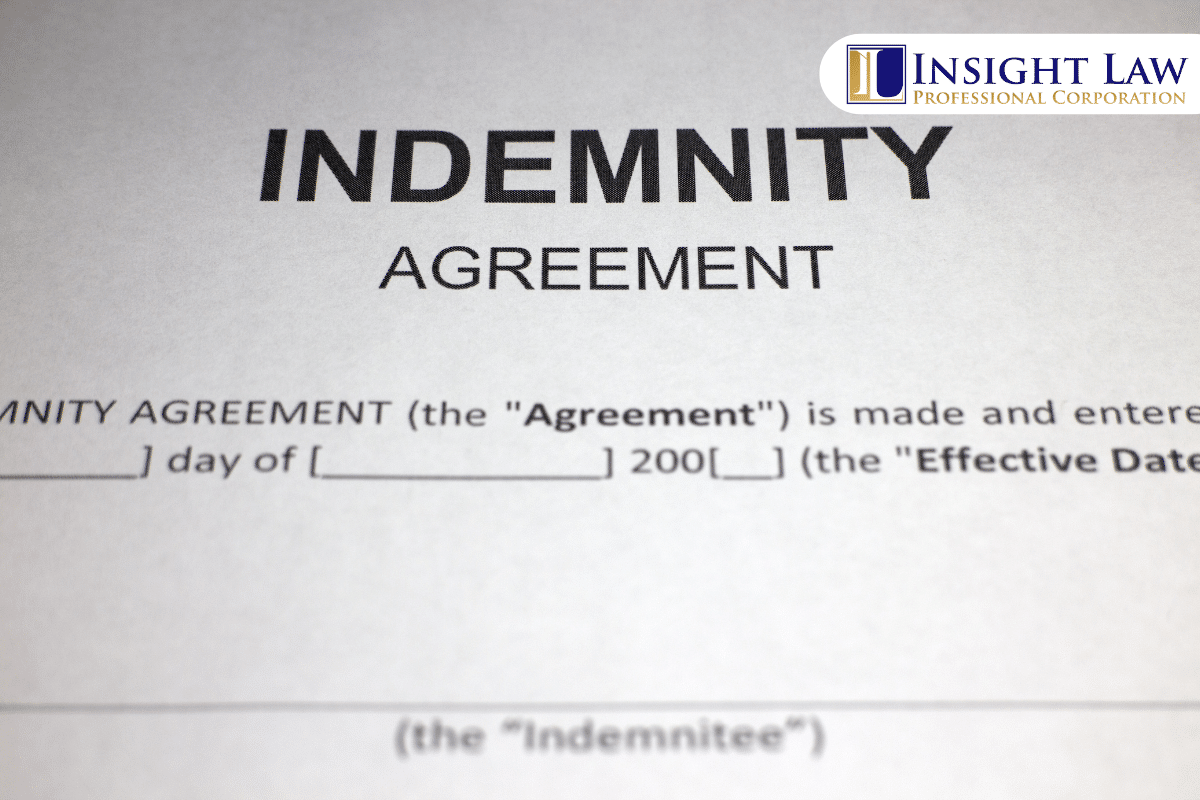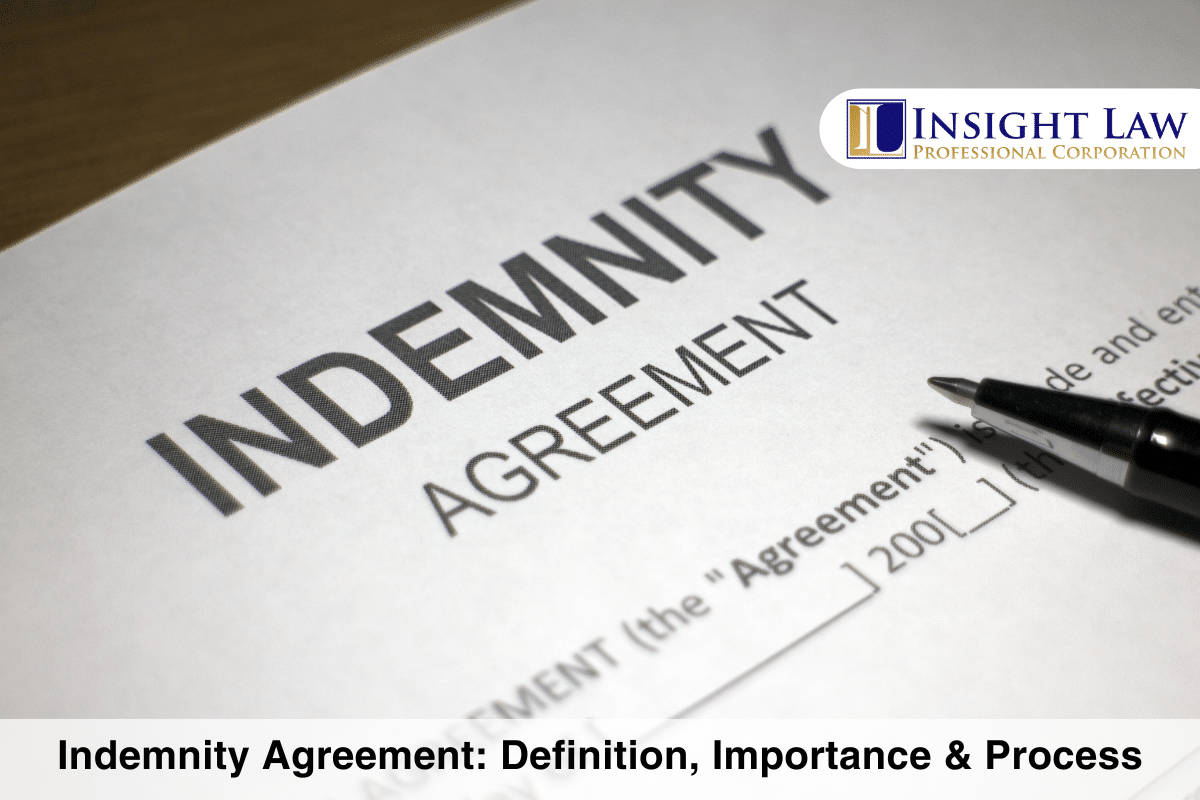An indemnity agreement is a legal document used primarily to safeguard one party against certain losses and liabilities arising from specific incidents.
Insight Law Professional Corporation is a business law firm. Whether you’re just starting out, looking to expand, or facing legal challenges, our team is here to provide the strategic advice and legal solutions you need. If you need guidance from a business lawyer, contact us and see how our firm can help.
What is an Indemnity Agreement?
An indemnity agreement is a legal contract that shields one party in a transaction from any risks or liabilities the other party may create. It is also called a hold harmless agreement, no-fault agreement, release of liability, or waiver of liability. For example, when renting a car, the rental company may require the renter to sign an indemnity agreement to free the company from any legal claim, loss or damage resulting from the renter’s use of the car. This implies that the rental company will not be held responsible for any resulting damage if an accident occurs while the renter uses the vehicle. The indemnity agreement protects the indemnified party from any lawsuits, damages, or claims made by third parties. The Indemnitor provides protection, while the indemnitee is the party being protected.

Importance of Indemnity Agreements
Indemnity agreements minimize the risk of financial exposure and legal complications from lawsuits. They are particularly valuable in situations involving high risks or large sums of money. For example, an indemnity agreement can protect the project owner from liabilities related to workplace accidents or property damage in construction projects. For professional services, these agreements ensure that a consultant or advisor can work without fearing being held financially responsible for issues beyond their control.
When to Use an Indemnity Clause
Here are some common situations where you should consider using an indemnity clause:
Engaging in High-Risk Activities: Indemnity clauses are crucial in agreements involving activities with inherent risks, such as construction, outdoor events, or activities that could cause environmental harm. These clauses help delineate liability and ensure that any party causing harm or damage takes responsibility, thus protecting other parties from undue financial or legal consequences.
Professional Services: Contracts involving professional services, such as consultants, architects, and engineers, often include indemnity clauses to protect against claims resulting from professional negligence or errors. This ensures that any financial losses arising from advice or services not meeting the contractual requirements are covered.
Use of Subcontractors or Third Parties: When subcontractors fulfill a contract’s requirements, indemnity clauses protect the primary contractor from liabilities arising from the subcontractors’ actions. This is essential to ensure that any mistakes or omissions by subcontractors do not financially harm the main contractor.
Product Liability and Supply Chain Agreements: Indemnity clauses protect buyers from defects or non-compliance that could lead to damages or losses in contracts where goods are manufactured or supplied. They also ensure suppliers can be held accountable for providing products that meet the agreed specifications and safety standards.
Intellectual Property and Licensing: When a contract involves using or transferring intellectual property, indemnity clauses are important to protect against infringement claims. This clause ensures that the licensor can cover any losses the licensee might incur if the intellectual property infringes on someone else’s rights.
Leasing and Real Estate: In real estate leases, indemnity clauses protect landlords and tenants by clearly stating who is responsible for damages or injuries on the property. This helps manage liabilities related to property use and ensures that each party understands their responsibilities in maintaining the property or addressing issues that may arise.

Key Components of an Indemnity Agreement
Here are the essential elements:
- Indemnification Clause: This is the core of the indemnity agreement, outlining the liabilities the indemnitee will be protected against. It specifies the types of losses, damages, or claims that the indemnifying party agrees to cover.
- Indemnification Period: This specifies the duration in which the agreement will protect the indemnitee from claims and legal actions. It is important to clearly define this period to avoid any ambiguities.
- Scope of Coverage: This refers to the circumstances under which the indemnification clause will apply. It details the specific situations, activities, or events that are covered by the agreement.
- Indemnification Exceptions: These specify conditions under which the indemnitor will not protect the indemnitee. Common exceptions include willful misconduct or gross negligence by the indemnitee.
- Notification and Defense: The agreement should outline how the indemnitee will notify the indemnitor of a dispute or claim covered under the legal document. It also details the process for the indemnitor to take over the defense of such claims.
- Settlement and Consent: This clause ensures that both parties must get each other’s consent before settling a claim covered in the contract. It helps in maintaining transparency and mutual agreement on the resolution of claims.
- Enforcement: The indemnity agreement should include a specific process for handling disputes and resolving disagreements. This ensures that there is a clear path to follow if any issues arise regarding the enforcement of the agreement.
The Process of Creating an Indemnity Agreement
The process at a high level involves the following steps:
- Identifying the Need: The first step is recognizing situations where an indemnity agreement is appropriate. This includes transactions or activities where liability risks are significant.
- Drafting the Agreement: The indemnity agreement should define what is covered and excluded. It should state explicitly the scope of indemnity, the duration of the agreement, and any limitations or caps on the amount to be indemnified.
- Negotiation: The terms of the indemnity agreement are negotiated by both parties. This negotiation ensures that the responsibilities and liabilities are fully understood and accepted by both the indemnitor and the indemnitee.
- Execution: Once both parties agree on the terms, the agreement is signed and becomes legally binding. Proper execution ensures that it is enforceable in court should disputes arise.
- Ongoing Review and Management: Given that business circumstances and legal frameworks can evolve, it is advisable to periodically review and potentially update indemnity agreements to ensure they remain relevant and effective.
Summary
Indemnity agreements are a tool for managing legal and financial risks. By clearly defining indemnity responsibilities, these agreements provide a safety net, allowing businesses and individuals to operate with greater assurance against potential legal claims. As with any legal document, it is highly recommended to consult with legal professionals when drafting or signing an indemnity agreement to ensure that it is comprehensive and tailored to the specific needs of the parties involved.
The information provided above is of a general nature and should not be considered legal advice. Every transaction or circumstance is unique, and obtaining specific legal advice is necessary to address your particular requirements. Therefore, if you have any legal questions, it is recommended that you consult with a lawyer.







